Chess Champ Kamsky Marches On
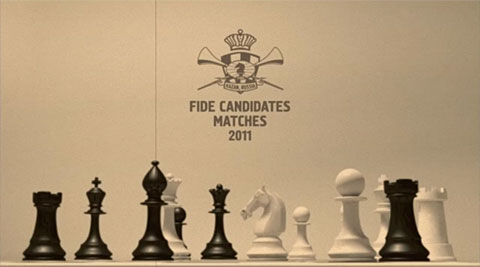
The top-seated Armenian grandmaster Levon Aronian was the heavy favorite to emerge as the winner of the 2011 FIDE Candidates matches in Kazan, Russia, and challenge Vishy Anand of India for the world chess title in 2012. According to the same scenario, Aronian's opponent in the Candidates Final was supposed to be the Bulgarian grandmaster Veselin Topalov. But both grandmasters are gone now, having lost the Candidates quarterfinal matches. Topalov was eliminated by the U.S. champion Gata Kamsky, Aronian lost to Alexander Grischuk of Russia.
The semifinals - Kamsky vs. Gelfand and Kramnik vs. Grischuk - resume Thursday and can be followed life on the FIDE web site or on Playchess.com.
Here is the quarterfinal wrap-up.
Alexander Grischuk - Levon Aronian 4.5 - 3.5
The match began in earnest with the rapid games after the first four regular games were drawn.
Grischuk won the match with an excellent victory in the last rapid game. He came into prominence during the 2000 FIDE knockout world championship in Delhi, qualifying for the semifinals where he lost to Alexei Shirov. In 2002, I talked to Grischuk after the Prague agreement was signed in the Czech capital. The agreement was a clumsy attempt to bring Garry Kasparov back to big chess and to unite the two world championship titles, but it left Vishy Anand and Grischuk out in the cold. "I don't mind," the 19-year-old Grischuk said. "I still have time, but I feel sorry about Vishy." Time heals all wounds. Anand, 41, is the world champion. Grischuk, 27, is going to meet the former world champion Vladimir Kramnik in the semifinal in Kazan. Could this be his year?
Vladimir Kramnik - Teimur Radjabov 7:5
For years, Radjabov tried to succeed in the elimination events by betting on the blitz games. The shorter the time limit, the better for him. It almost worked against Kramnik. After drawing four regular and four rapid games, Radjabov won the first blitz game. Kramnik needed a win in the next game and got only a small edge in the endgame when the game clock stopped working. When the game resumed, Radjabov's position collapsed quickly. Kramnik, who in his youth could match Garry Kasparov move by move in blitz games, clinched the victory in the match by triumphing in the last two games.
Boris Gelfand - Shakryiar Mamedyarov 2.5 - 1.5
Gelfand made his victory look easy by drawing three and winning one game, leaving his opponent without chances. The Israeli grandmaster knows the Najdorf Sicilian with the black pieces inside out and Mamedyarov played right into it in the only decisive game. Gelfand blunted white's attack with a thematic exchange sacrifice and grabbed many pawns, forcing the Azerbaijani GM to resign. Gelfand will meet Kamsky in the semifinals.
Gata Kamsky - Veselin Topalov 2.5 - 1.5
Despite winning the U.S. championship last month, Kamsky was not given much hope against Topalov. After all, the Bulgarian grandmaster beat him 4.5 - 2.5 in the World Chess Challenge in Sofia in 2009. For the match in Kazan, Topalov as white prepared a few novelties against the Grunfeld defense and twice gained some advantage from the opening. But Kamsky has always been a terrific fighter, not to be brought down easily. In the game he won, Kamsky played creatively and neutralized white's initiative rather quickly. Topalov's initiative stalled, he could not find a good plan and succumbed to Kamsky's fiery attack (see below). In the last game, Kamsky needed a draw to clinch the match. He was in the same situation at the U.S. championship. His opponent, Yuri Shulman, opened the game too early and Kamsky equalized handily and won the title. "He should have built up the game more slowly and put pressure on me," Kamsky advised. And it was precisely what Topalov did. In time trouble, Kamsky blundered and it seemed Topalov could win as he pleased. But he picked the wrong way and Kamsky found a way out.
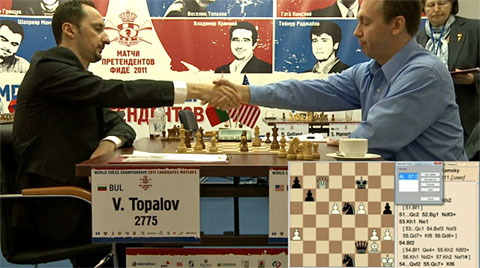
Topalov (left) conceding the quarterfinal match to Kamsky.
Topalov - Kamsky
Game Two
World Championship Candidates - Quarterfinals, Kazan 2011
1.Nf3 Nf6 2.c4 g6 3.Nc3 (White's move order was adopted by the world champions Alexander Alekhine, Anatoly Karpov, Garry Kasparov, Vladimir Kramnik and many others who tried to make life of the Grunfeld defense players more difficult.) 3...d5 4.cxd5 Nxd5 5.Qb3 (In the last game of the match Topalov came up with 5.Qc2 Bg7 6.e4 Nb6 7.d4 0-0 8.Be3 Bg4 9.Ne5 Bxe5 10.dxe5 Nc6 11.h3 Be6 12.Rd1 Qc8 13.f4 Rd8 14.b3 Nb4 15.Rxd8+ Qxd8 16.Qb1 f5 17.exf6 exf6 18.Be2 Qe7 19.0-0 and with a bishop pair and the pawn control in the center white had a lasting advantage.
The most popular move 5.Qa4+ was played by Alekhine against Rellstab in Kemeri already in 1937. In the absence of the white pawn on d4, the queen can roam along the fourth rank. The game continued: 5...c6 6.Qd4 Nf6 7.Qxd8+ Kxd8 8.d4 b6 9.e4 and the strong pawn center gave white a clear advantage.)
5...Nb6 (Black's position after 5...Nxc3 6.Qxc3 Rg8 does not inspire confidence.) 6.d4 Bg7 7.Bf4 Be6 8.Qa3 (Since the great Ukrainian GM Vasily Ivanchuk played it twice, the queen move should not be dismissed. On the other hand, Ivanchuk is capable of making almost anything work. Still, the queen is out of play and may remain there.) 8...Nc6 (Developing and hitting the center is not a bad idea.)

9.0-0-0 (Topalov's novelty. White is threatening to win a piece with d4-d5. Both Ukrainian grandmasters, Eljanov and Ivanchuk, played 9.e3 against Kamsky and he was able to survive.)
9...Nd5!? (Blocking the dangerous d-pawn is the best choice. After 9...a6? 10.d5! White wins either after 10...Bxd5 11.e4 or after 10...Nxd5 11.Nxd5 Bxd5 12.e4. After 9...f5 10.e3 black's position is uncomfortable.) 10.Bg3 (Black has to deal with the king-pawn strike e2-e4 and Kamsky tackles the problem rather originally.) 10...Bh6+ (After 10...Bf5 comes 11.Qc5!) 11.e3 a5 12.h4 (White tries to take advantage of black's dark bishop by attacking along the h-file. Topalov could have renewed the threat of e3-e4 with 12.Kb1 and now 12...Ncb4!? 13.e4 c6 a tricky computer move, preventing 14.exd5? Bf5+ and black wins; another idea is 12...Bf5+ 13.Bd3 Nxc3+ 14.bxc3 [14.Qxc3 Qd5!] 14...Bxd3+ 15.Rxd3 0-0 16.Rhd1 with white's edge.)
12...Ncb4 (Sometimes it is a good idea to reflect into the past. The game Korchnoi-Spassky, Candidates match 1968, comes to mind. Spassky had a knight on b4, Korchnoi attacked it with a pawn (a3) and black "protected" it with a cool move a7-a5.
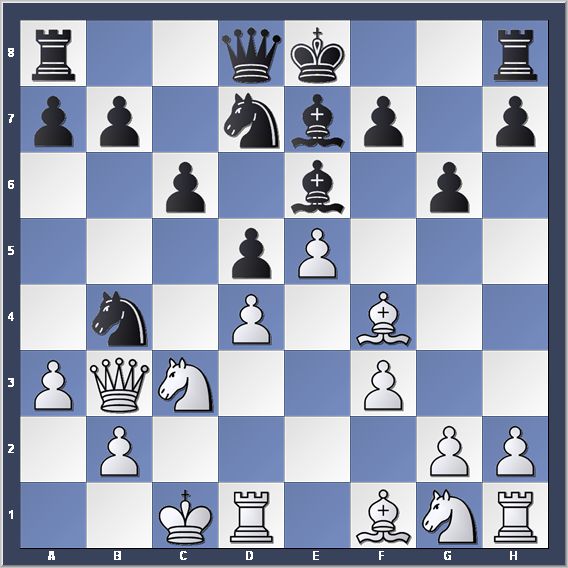
12... a5! 13.axb4 axb4 The piece sacrifice worked well and Spassky was soon winning. 14.Nb1 [After 14.Nce2 c5 15.Nh3 c4 16.Qe3 Nb6 black has a powerful attack. ] 14...c5! 15.g4 c4 16.Qe3 Ra2 17.h4 Qa5 18.Rh2 Ra1 19.Bd3 b3 20.Ne2 [Black gets back the piece a should win. Mikhail Tal recommended 20...cxd3 21.Qxd3 h5!] Spassky played 20...Bb4 and later misplayed the position and lost:
21.h5 0-0 22.hxg6 fxg6 23.Rdh1 cxd3 24.Qxd3 Qc7+ 25.Nec3 Nb6 26.Qxg6+ hxg6 27.Rh8+ Kf7 28.R1h7+ Ke8 29.Rxf8+ Kxf8 30.Rxc7 Nc4 31.Rxb7 Bxc3 32.bxc3 b2+ 33.Kc2 Ke8 34.Bg5 Ra6 35.Nd2 Bc8 36.Re7+ Kf8 37.Nxc4 dxc4 38.Kxb2 Rb6+ 39.Kc2 Bb7 40.Rxb7 Rxb7 41.f4 Rh7 42.Kb2 1-0
But Topalov is unable to attack the knight on b4 with a pawn, because his queen stands in the way.)

While Kamsky (in blue shirt) and Topalov think, the Russian commentators discuss the knight leap 13.Ng5.
13.h5 (Instead of marching forward, Topalov could have used the h-pawn to plug in his knight: 13.Ng5 Bg4 14.Rd2 f6 15.Nge4 with a playable game.) 13...c6 (Kamsky makes a solid choice. The computers are begging for 13...Nxe3 14.fxe3 Bxe3+ 15.Rd2 (15.Nd2 Qxd4) 15...0-0 with roughly equal chances.) 14.hxg6 hxg6 15.Rd2 (Topalov begins to lose the thread. He is defending against 15...Bxe3+, but the simple 15.Be2 ,connecting the rooks, was better.) 15...f6 16.Ne4 b6 (With the last two pawn moves, Kamsky protected important dark squares in his camp and assumed the command in the center.) 17.Be2

17...Qc8! (Black would have loved to open the c-file and this is the first step. It was also possible to connect the heavy pieces with 17...Kf7, for example 18.Rdd1 Nxa2+ 19.Qxa2 Nxe3 20.Qa3 Nxd1+ 21.Kxd1 with black's edge.) 18.Rh4 Kf7 (18...Bf5 19.Nc3 Qe6 20.Qb3 b5 was a good alternative.) 19.Rd1 g5 (Obviously, Kamsky has the break c6-c5 in mind, but he could have reshuffled his pieces decisively with 19...Bf5!, for example 20.Nfd2 [20.Bc4 g5+-] 20...Qe6 21.Rdh1 Bxe3 22.fxe3 Rxh4 23.Rxh4 g5 and black should win.) 20.Rh2 g4 (20...Nxa2+?! 21.Qxa2 Nc3 22.Qxe6+ Qxe6 23.Nxc3 does not look too great for black.) 21.Nfd2 c5! (Earlier, Kamsky could have played the combination Nxa2+/Qxa2 Nxe3, but opening the c-file has a devastating effect on the white king.)
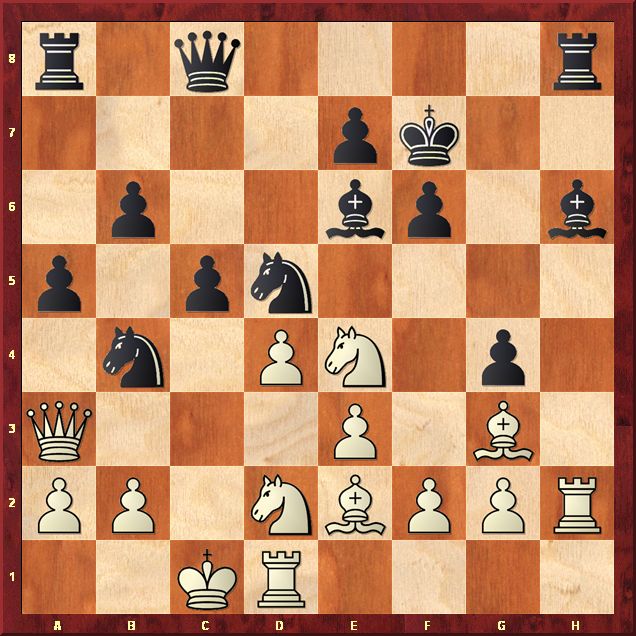
22.dxc5 f5 23.Rxh6 (The exchange sacrifice is rather forced, but it does not save white. After 23.Rdh1 fxe4 24.Rxh6 Qxc5+ 25.Bc4 Rxh6 26.Rxh6 Nf6 27.Qc3 Bxc4 28.Qxc4+ Qxc4+ 29.Nxc4 Rc8 black wins.
And after 23.Nc3 Qxc5 24.Kb1 f4 white may not solve the problems along the b1-h7 diagonal.) 23...Rxh6 24.Ng5+ Kf8 25.Nxe6+ Qxe6 26.Bc4 Rc8! 27.Bf4 (After 27.Kb1 Rxc5 28.Qb3 b5 29.Bd3 Qc8 30.a3 Rhc6! black finishes the game triumphantly on the c-file.) 27...Rf6 28.e4 (The last attempt to confuse black, but Kamsky finds a pretty refutation.)
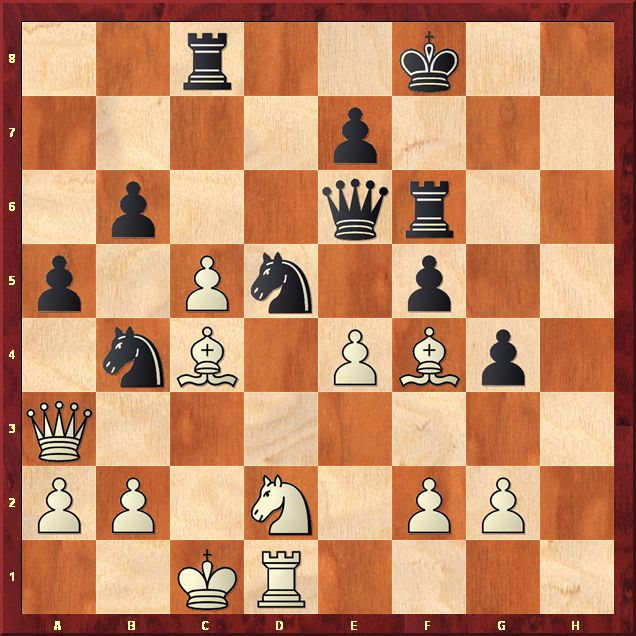
28...Rxc5! 29.exd5 Qxd5 (The queen sneaks in decisively.) 30.b3 (After 30.Qc3 Rxc4! black wins either after 31.Qxc4 Rc6; or after 31.Nxc4 Nxa2+ 32.Kc2 Qe4+ 33.Qd3 Nb4+ winning the queen. And after 30.Qb3 b5 wins.) 30...Qd4 31.Be3 (Black wins either after 31.Kb1 Qxf4; or after 31.Qb2 Nd3+.) 31...Qc3+ (After 32.Kb1 Qc2+ wins.) White resigned.
Note that in the replay windows below you can click either on the arrows under the diagram or on the notation to follow the game.
Images from the official site.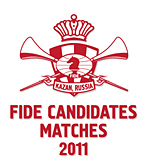
No comments:
Post a Comment